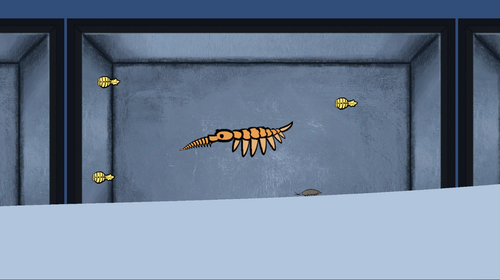Anomalocaris Simulator - Log #1

9/29/29, Friday
3:30pm
For reference, the player plays as an anomalocaris canadensis, a type of radiodonta.
Scrapped the feature of the anomalocaris crushing prey with appendage, due to research published around July 2023 disproving this ability.
Plan for Appendage rework:
In order to more flexibly grab prey, I’ll rework the Anomalocaris’ Appendage object to hold a list of AppendageSegment objects, which will all be individually bent.
- The Appendage class will have a method called Bend(), which iterates over each AppendageSegment object and calls BendSegment() on each of those objects.
Decision:
- I originally aimed to have a mix of biological accuracy, and simplicity for the sake of visibility and the jam’s time constraint. However, I want to make the appendage movement as accurate as I can.
- So, I’ll make the Appendage have 13 segments:
- 1 root segment (unspiked),
- 11 middle segments (spiked), and
- 1 end segment (unspiked).
- Another impact on this decision is that I now want to make this jam submission more of an Anomalocaris movement simulator, rather than a hunt-and-survive type game.
More Specific Plan:
- Each AppendageSegment should bend a small amount.
9:50pm
Appendage Progress:
The appendage now bends using segments, all of which can rotate up to a specified amount.
My next step is to allow the root segment to rotate up to 90 degrees, and the rest roughly 12 degrees. I noticed that the root segment has the most mobility, so I want to replicate this.
9/30/29, Saturday
8:10pm
The last two things I want to implement before submitting are:
- being able to eat prey (for now, this is limited to small, soft body creatures like the vetulicolia.
- Implementing swimming for the vetulicolia (fish-like creature).
I’ve completed most of the setup for the vetulicolia, so my current task is to allow the anomalocaris to eat it. My process for this is:
- When the player presses the given button for curling the anomalocaris’ appendage towards its mouth:
- every appendage segment will check if an object of type <SoftBody> is in the trigger of this segment.
- If the object is found, call the method on the segment for grabbing the soft body, passing in the SoftBody object, then signal the appendage to stop checking for SoftBody objects for the remainder of the curling motion.
- At the end of the motion, if the anomalocaris has a SoftBody object in the capture zone, it will eat it.
10/1/23, Sunday
Future Goals:
In order to more flexibly construct different species of radiodonta, I plan to further construct the creature’s parts separately. These parts are:
- Appendage (optional)
- Appendage should be either abstract or an interface
- This is because there are at least 4 distinct kinds of appendages among the radiondonta
- The anomalocaris canadensis has roughly 13 podomeres (appendage segments), each of which maintain similar shape, but decrease in size from the root segment towards the tip podomere.
- The amplectobelua symbrachiata’s fourth podomere has a distinctly sizable spike.
- The aegirocassis benmoulai has 7 podomeres, five of which have straight spines facing perpendicular to the base appendage.
- The hurdia victoria has appendages similar to the anomalocaris, however the hurdia’s are much smaller
- Body
- Each radiodont’s body tends to consist of one shell after another. Each body shell is usually accompanied by a fin
- Fins (optional)
- Due to one radiodonta that has no fins (the schinderhannes bartelsi, I’ve classifed the fins as optional, but highly prevalent.
- Tail
- Most radiodonta have a tail-like at the end of their final body segment.
- Some radiodonta also have long, antenna-like bits in addition to the tail
Files
Get Anomalocaris Simulator
Anomalocaris Simulator
There is no win condition, only anomalocaris.
| Status | Prototype |
| Author | Arturo C-Zacarias |
| Genre | Simulation |
| Tags | Animals, underwater |
Leave a comment
Log in with itch.io to leave a comment.